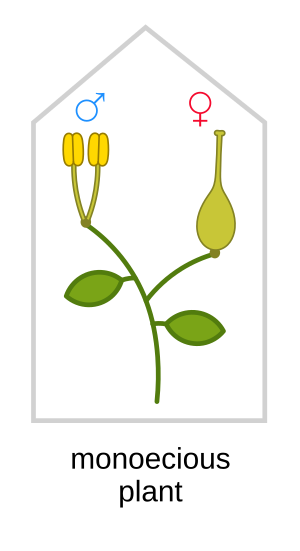Monoecy

Monoecy(/məˈniːsi/;adj.monoecious/məˈniːʃəs/)[1]is asexual systeminseed plantswhere separatemaleandfemalecones or flowers are present on the same plant.[2]It is a monomorphicsexual systemcomparable withgynomonoecy,andromonoecyandtrimonoecy,and contrasted withdioecywhere individual plants produce cones or flowers of only one sex and with bisexual or hermaphroditic plants in which male and female gametes are produced in the same flower.[3]
Monoecy often co-occurs withanemophily,[2]because it preventsself-pollinationof individual flowers and reduces the probability of self-pollination between male and female flowers on the same plant.[4]: 32
Monoecy inangiospermshas been of interest forevolutionary biologistssinceCharles Darwin.[5]
Terminology
[edit]Monoecious comes from the Greek words for one house.[6]
History
[edit]The term monoecy was first introduced in 1735 byCarl Linnaeus.[2]Darwinnoted that the flowers of monoecious species sometimes showed traces of the opposite sex function, suggesting that they evolved via hermaphroditism.[7]Monoecioushempwas first reported in 1929.[8]
Occurrence
[edit]Monoecy is most common intemperate climates[9]and is often associated with inefficient pollinators orwind-pollinatedplants.[10][11]It may be beneficial to reducing pollen-stigma interference,[clarification needed]thus increasing seed production.[12]
Around 10% of allseed plantspecies are monoecious.[9]It is present in 7% ofangiosperms.[4]: 8 MostCucurbitaceaeare monoecious[13]including mostwatermeloncultivars.[14]It is prevalent inEuphorbiaceae.[15][16]Dioecy is replaced by monoecy in polyploid populations ofMercurialis annua.[17]
Maize
[edit]Maizeis monoecious since bothpistillate(female) andstamenate(male) flowers occur on the same plant. The pistillate flowers are present on the ears of corn and the stamenate flowers are in the tassel at the top of the stalk. In theovulesof the pistillate flowers,diploidcells called megaspore mother cells undergomeiosisto produce haploidmegaspores.In the anthers of the stamenate flowers, diploidpollenmother cells undergo meiosis to produce pollen grains. Meiosis in maize requires gene productRAD51,a protein employed inrecombinational repairofDNA double-strand breaks.[18]
Evolution
[edit]The evolution of monoecy has received little attention.[7]
Male and female flowers evolve from hermaphroditic flowers[19]viaandromonoecyorgynomonoecy.[20]: 148
Inamaranthsmonoecy may have evolved from hermaphroditism through various processes caused by male sterility genes and female fertility genes.[20]: 150
Monoecy may be an intermediate state between hermaphroditism and dioecy.[21]Evolution from dioecy to monoecy probably involvesdisruptive selectionon floral sex ratios.[22]: 65 Monoecy is also considered to be a step in the evolutionary pathway fromhermaphroditismtowards dioecy.[23]: 91 Some authors even argue monoecy and dioecy are related.[2]But, there is also evidence that monoecy is a pathway fromsequential hermaphroditismto dioecy.[23]: 8
See also
[edit]References
[edit]- ^"monoecious".LexicoUK English Dictionary.Oxford University Press.Archived fromthe originalon September 5, 2021.
- ^abcdBatygina, T. B. (2019-04-23).Embryology of Flowering Plants: Terminology and Concepts, Vol. 3: Reproductive Systems.CRC Press. p. 43.ISBN978-1-4398-4436-6.
- ^Torices, Rubén; Méndez, Marcos; Gómez, José María (2011)."Where do monomorphic sexual systems fit in the evolution of dioecy? Insights from the largest family of angiosperms".New Phytologist.190(1): 234–248.doi:10.1111/j.1469-8137.2010.03609.x.ISSN1469-8137.PMID21219336.
- ^abKarasawa, Marines Marli Gniech (2015-11-23).Reproductive Diversity of Plants: An Evolutionary Perspective and Genetic Basis.Springer.ISBN978-3-319-21254-8.
- ^Nozaki, Hisayoshi; Mahakham, Wuttipong; Heman, Wirawan; Matsuzaki, Ryo; Kawachi, Masanobu (2020-07-02)."A new preferentially outcrossing monoicous species of Volvox sect. Volvox (Chlorophyta) from Thailand".PLOS ONE.15(7): e0235622.Bibcode:2020PLoSO..1535622N.doi:10.1371/journal.pone.0235622.ISSN1932-6203.PMC7332039.PMID32614898.
- ^Purves, William K.; Sadava, David E.; Orians, Gordon H.; Heller, H. Craig (2001).Life: The Science of Biology.Macmillan. p. 192.ISBN978-0-7167-3873-2.
- ^abPedersen, Roger A.; Schatten, Gerald P. (1998-02-03).Current Topics in Developmental Biology.Academic Press. p. 180.ISBN978-0-08-058461-4.
- ^Rowell, Roger M.; Rowell, Judith (1996-10-15).Paper and Composites from Agro-Based Resources.CRC Press. p. 49.ISBN978-1-56670-235-5.
- ^abWillmer, Pat (2011-07-05).Pollination and Floral Ecology.Princeton University Press. p. 85.ISBN978-1-4008-3894-3.
- ^Glover, Beverley (February 2014).Understanding Flowers and Flowering Second Edition.Oxford University Press. p. 139.ISBN978-0-19-966159-6.
- ^Friedman, Janice; Barrett, Spencer C. H. (January 2009)."The Consequences of Monoecy and Protogyny for Mating in Wind-Pollinated Carex".The New Phytologist.181(2): 489–497.doi:10.1111/j.1469-8137.2008.02664.x.JSTOR30224692.PMID19121043.
- ^Patiny, Sébastien (2011-12-08).Evolution of Plant-Pollinator Relationships.Cambridge University Press. p. 33.ISBN978-1-139-50407-2.
- ^Pessarakli, Mohammad (2016-02-22).Handbook of Cucurbits: Growth, Cultural Practices, and Physiology.CRC Press. p. 171.ISBN978-1-4822-3459-6.
- ^Prohens-Tomás, Jaime; Nuez, Fernando (2007-12-06).Vegetables I: Asteraceae, Brassicaceae, Chenopodicaceae, and Cucurbitaceae.Springer Science & Business Media. p. 390.ISBN978-0-387-30443-4.
- ^Webster, G. L. (2014). "Euphorbiaceae". In Kubitzki, Klaus (ed.).The Families and Genera of Vascular Plants - Volume XI - Flowering Plants, Eudicots - Malpighiales.Heidelberg:Springer.pp. 51–216/x+331.ISBN978-3-642-39416-4.OCLC868922400.ISBN978-3-642-39417-1.ISBN3642394167.
- ^Bahadur, Bir; Sujatha, Mulpuri; Carels, Nicolas (2012-12-14).Jatropha, Challenges for a New Energy Crop: Volume 2: Genetic Improvement and Biotechnology.Springer Science & Business Media. p. 27.ISBN978-1-4614-4915-7.
- ^Volz, Stefanie M.; Renner, Susanne S. (2008)."Hybridization, polyploidy and evolutionary transitions between monoecy and dioecy in Bryonia (Cucurbitaceae)".American Journal of Botany.95(10): 1297–1306.doi:10.3732/ajb.0800187.PMID21632334.
- ^Li J, Harper LC, Golubovskaya I, Wang CR, Weber D, Meeley RB, McElver J, Bowen B, Cande WZ, Schnable PS (July 2007)."Functional analysis of maize RAD51 in meiosis and double-strand break repair".Genetics.176(3): 1469–82.doi:10.1534/genetics.106.062604.PMC1931559.PMID17507687.
- ^Núñez-Farfán, Juan; Valverde, Pedro Luis (2020-07-30).Evolutionary Ecology of Plant-Herbivore Interaction.Springer Nature. p. 177.ISBN978-3-030-46012-9.
- ^abDas, Saubhik (2016-07-25).Amaranthus: A Promising Crop of Future.Springer.ISBN978-981-10-1469-7.
- ^Kinney, M.S.; Columbus, J.T.; Friar, E.A. (2007)."Dicliny in Bouteloua (Poaceae: Chloridoideae): Implications for the evolution of dioecy".Aliso: A Journal of Systematic and Floristic Botany.23(1): 605–614.
- ^Avise, John (2011-03-15).Hermaphroditism: A Primer on the Biology, Ecology, and Evolution of Dual Sexuality.Columbia University Press.ISBN978-0-231-15386-7.
- ^abLeonard, Janet L. (2019-05-21).Transitions Between Sexual Systems: Understanding the Mechanisms of, and Pathways Between, Dioecy, Hermaphroditism and Other Sexual Systems.Springer.ISBN978-3-319-94139-4.
